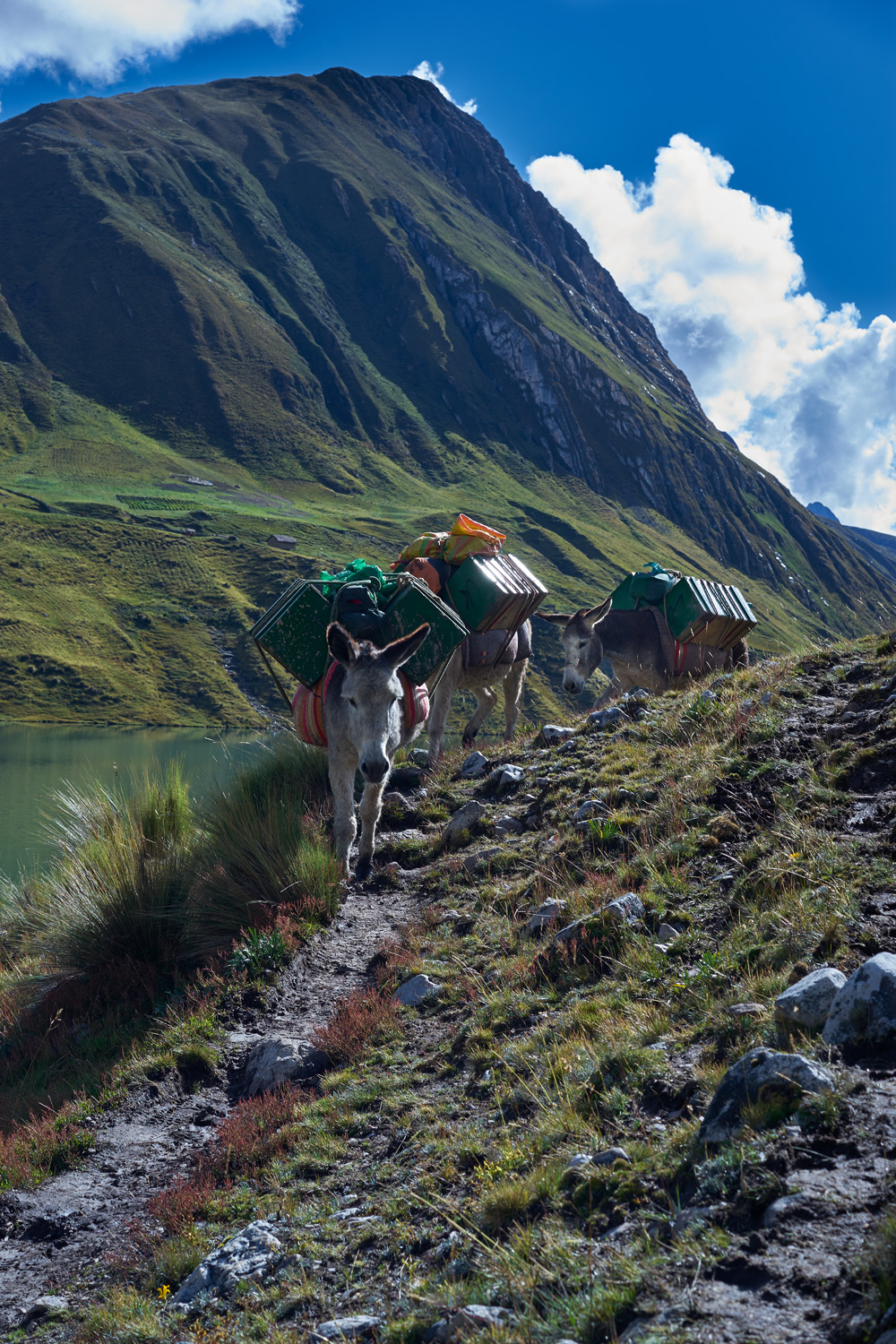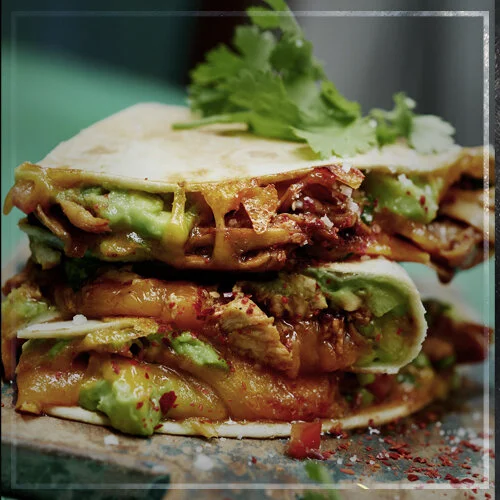Wanderlust – Mountain Hiking in Peru
Click, clack-click, click, clack – my hiking poles pass over the mule-trodden rugged path. The dirt, softened by the heavy rainfall of the last week, suctions heavily onto my boots. I am absorbed by my monotonously slow gait.
I pull myself up the slope as if in slow motion. During the first hundred metres of the ascent, the murky drizzle turns into powdery snowflakes that melt away at first but then settle as a white layer on the mountaintops, still lying in shadow around me. Around 500 metres above me lies the first pass of our mountain tour, “Cacananpunta”, at 4690 metres above sea level. Peruvians proudly proclaim that their mountains are the highest on Earth. At the moment, being in the midst of it all, I can understand their calculations. I barely glance upwards, so concentrated am I on my steps as well as the cold, which penetrates through the layers of my clothing and into my body despite the strenuous climb.
My thoughts wander back to my second trip to Peru in 1982: I met André in Huaraz who convinced me, in a jumbled mishmash of English and Spanish, to go to the Cordillera Huayhuash with him. He was a mountain tour guide who had worked on Mont Blanc before and wanted to scale Mount Rasac (6017 metres). In those days, armed with nothing more than jeans, cotton t-shirts, a Shetland jumper, a K-Way jacket, the naivety of a lowlander and a curiosity for the landscape, I found my love for Peru, this region, and the Yerupaja, the country’s second highest mountain.
Peru shaped my life in the following years: A year later in Hamburg, I married a then psychology student from Iquitos, successfully applied for the Bavarian State Academy of Photography with the travel photos from 1982, and our children grew up with Valz Peruano, Huayno and the Afro-Peruvian beats of the coast.
I knew what I was getting myself into on this trip and what awaited me! And now back to the climb: Doubt envelopes me concerning my fitness, the 13-day hike with thousands of demanding metres to climb that lies before me, and the heavy rainfall situation caused by “el niño”. Did the reason for this trip lie in the knowledge that time for such adventures is defined by the ticking of one’s own biological clock?
I am suddenly pulled away from my thoughts as Mario’s donkeys push me off the track and pass me from behind in a trot, light-footedly racing past despite of their heavy luggage. Roger, our indigenous tour guide, Martin, our friend from Bonn, his wife Susanne and I had left the camp in Quartelhuain at six in the morning, leaving behind Benjamin, the cook from Ancash and the donkey driver Mario. Now, three hours later and shortly before the pass, we are overtaken by them as if the ascent were a pleasant Sunday stroll along the Elbe. The crutches strapped onto the last donkey remind me that my preparations for the trip had gone completely differently than planned. My knee, which was operated on last year and is now in a pressure sleeve, is doing well. The sky opens up and the pass rewards us with a magnificent 100-kilometre view into the distance all the way to Cordillera Blanca.
The gas light illuminates the tent’s orange wall and throws a soft light onto our still tired faces. The night went down to -6 degrees. We gratefully soak up the warmth of the cooking area and crowd around the lovingly set folding table. The daily quinoa puree with cinnamon and clove sits steaming on the table and next to Benjamin, who balances a cutting board on his knees, the dented, black-burnt kettle begins to bubble. The options are coca tealeaves, coffee or Ovaltine. A nutritious, authentic cuisine was important to us when we chose our Peruvian hiking organiser. Other criteria were the ability to go at our own pace in a small group and to be accompanied by a mule in case of an emergency. We wanted to be prepared because each of the campgrounds in the communities in the Huayhuash National Park were at least 2 days by foot from the nearest drivable road. Only on day 10, with an overnight stay in the 300 soul-village Huayllapa, could an injured person be transported if need be.
As every morning Roger explains to us the day’s route with the help of his Alpine Association map. Our strength restored, we step into the freezing morning, ready for Rondoy, Miturachu, Jirishanca and the other mountain giants named in Quetchua, the language of the Incas.
The trails change their coatings, from slush to pillow-like, green carpets. Knee-high reeds skirt silvery-grey to crimson coloured gravel paths, overgrown gurgling streams crisscross the trail. I have never studied so adamantly the diversity of cow paddies and donkey dung. Our view widens into the endlessness of the mountain peaks and cloud formations, and then again narrows on our next break down to two lovemaking caterpillars next to our sandwiches. In the updrafts circle condors, avalanches thunder down the steep cliffs and now and again my glance pauses on Martin’s altimeter. It shows 5013 metres. Nevado Cuyoc to my right seems close enough to touch, even though we still have to climb another 500 metres to the summit. We are euphoric. Nature could not be more magistic!
We can barely part from this place. As Roger claims that it isn’t much further to our camp in “Elefante Pampa”, I decide to stay for a photo at dusk. Equipped with Roger’s walkie-talkie and Martin’s jacket, I gaze after the three until their shapes become ever smaller and then disappear altogether. It is silent in between rock and cliff formations. Alone, only me and the wind. Five hours until dusk. Half-asleep on myrain poncho spread out on the ground, I mumble Roger’s directions to the camp. Two hours later I bring this undertaking to an end. Dauntingly, clouds begin to gather, and I have to scrap the idea of a photo with mountain peaks in red twilight.
“After the valley keep to the right until you come across the river”, Roger had said and with every kilometre descent I search more strenuously for the fork in the trail. In the meantime, the mountains have completely vanished in fog, and it begins to rain. I follow the path up to a ridge resembling an elephant’s back, but behind that our tents are still nowhere to be seen. Damn! Lost in Huayhuash? I grab my walkie-talkie, it works after a few extremely long seconds and to my relief Roger describes the way back to camp in a rasping radio voice.
We spend the evenings in our kitchen tent, teaching Roger card games like Yahtzee and Uno. Now that he has a better idea of our mountaineering abilities, Martin’s plans of climbing “Diablo Mudo” come repeatedly into the conversation. Martin and I had rented the needed boots, crampons, picks, harnesses and helmets in Huaraz and had the equipment carried by the donkeys the whole time just in case. Though the climb was described by Roger as totally trouble-free, we still had our misgivings regarding a mountain that is dubbed the “silent devil”.
To climb a six-thousander at the age of 60 could be the tour’s crowning achievement. On day 11, with the effects of a 1300-meter climb in our legs, we have to make a decision.
Gashpampa, an icy, windy and sparse camping ground 4600 metres up on a plateau, would become our base camp for Diablo Mudo. As is common in the Andes, the ascent is only possible at night due to the brittleness of the glacier’s ice caused by high sun exposure.
Susanne, accompanied by Benjamin and Mario, would reach our last station Jahuacocha by the means of the normal route, while Roger, with Martin and me in tow, would be taking the detour over the Diablo Mudo.
2:00 in the morning: Departure. Around four to five hours in the dark for the 750 metre climb to the summit. The last 300 metres of the climb on glaciers, then a seven hour descent to camp in Jahuacocha lie in front of us.
After testing the crampons and the harnesses, we head to bed at 19:00. I can't get a wink of sleep out of excitement. When the alarm goes off at 1:00 in the morning, I feel as if my head is about to explode. I give up. Martin also doesn’t seem too chirpy. With the words “bloody testosterone” he stoically ladles soup into his mouth. At 1:43 he and Roger step outside into the clear, starry night. I wish them luck and watch as they recede until the cones of light from their headlamps are swallowed by the darkness.
While brushing our teeth in the morning, Susanne and I are already searching the white peaks of Diablo Mudo for two black dots moving slowly along. Again and again we turn around on our way to the mountain pass, llaucha Punta, and indeed, at 7:30 I believe to have seen the two mountaineers with my telephoto lens. We happily arrive at Jahuacocha and reserve two cold beers, which are sold under the table by the indigenous people, for our “heroes” who would be arriving two hours later.
“Quando un amor se va”, warbles “Los Apus” from Benjamin’s radio, while Roger explains how Martin only overcame his fear of heights because in the darkness of the ascent he couldn’t see how far down the treacherous ridges went. Martin is scarred from the ordeal, though now he grins at every anecdote of their shared experience. Touched, we thank our companions on this last evening for the time spent with them. A truly enriching time.
Three days later in the “Central”, a highly decorated top restaurant in Lima, the adventures of the last two weeks are still with us. When reading the 12-course menu accompanied with altitude metres, we come across “Lake Floor – 2900 m.” and “Chicken Chuño and Cuchuro”, a type of high altitude Andes algae which grows naturally on the lake shores.
“Old hat”, “already know it”, we collectively spout. “Benjamin already fished some of that out of Juraucocha and turned it into Ceviche for our dinner”…
Peru Qorianka Travel – www.peruqorianka.com
FREE MEN`S WORLD – www.freemensworld.de























